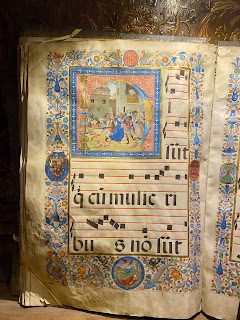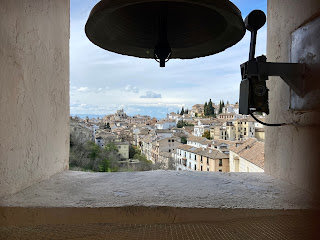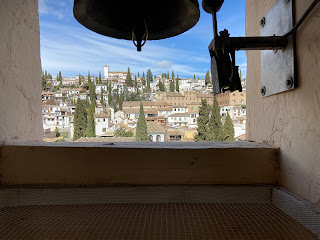We are still hungover on architecture after our trip to the Alhambra yesterday. In such a condition, the Catedral might not seem like the best place to visit, but for us, it's a 'hair of the dog' situation.
As in Sevilla, the interior of the S A I Catedral Metropolitana Basílica de Granada (sixteenth century), also reflects the layout of a prior mosque. It's five bays wide, two aisles aside and a central nave. Also as in Sevilla, the open area near the Puerta Principal is three bays deep to the Coro, the Coro is (was) two bays, and there is an open bay to the Capilla Mayor. But, unlike Sevilla, the Coro is open front-to-back, so the worship space is continuous; it is simply enclosed on the sides by the pipe organs.
From the exterior, we know the heights of the aisles step up to the nave, which is tallest. Also unlike Sevilla, the surfaces are 'whiter' and lighter; the classical language (Corinthian Order) is clearly expressed. Also helping, the artificial lighting is well-balanced; and though the feature windows are stained glass, the clerestory windows are clear, lifting the arches and vaults. Despite the underpinnings of the old mosque, this feels like a Renaissance interior.
There are a number of fascinating chapels. For example, the Capilla de Nuestra Señora de las Angustias (Our Lady of Sorrows) features a Pietà within a formal wooden retable, and an Annunciación in the stained glass above, framed in a Serliana. The ironwork text along the top of the railing quotes from Lamentations 1:12:
O vos omnes qui transitis per viam attendite et videte si est Dolor sicut Dolor meus[You, all of you who pass along the road, look and see if there is pain similar to the pain that is inflicted on me.]
The Capilla Mayor is a glorious domed structure with radiating chapels. The dome itself is ten bays, with three facing towards the nave, ribbed in gold, and finished with a cascade of stars against a sea-green field. The upper row of arched windows contain a cycle of stained glass panels, though they are almost impossible to read, given the angle and the lack of access to the altar. The Crucifixion is at the center rear, Christ carrying the cross to the left, and the deposition to the right – as we saw in Batalha and Alcobaça).
Around the Capilla Mayor is a seven-segment, semi-circular ambulatory; the wedge-shaped archways creating a 'forced-perspective'. There is limited natural light at the chapels at the back, so not as easy to enjoy. The altarpiece is a tempietto (ciborium), unusual, but perhaps architecturally appropriate given the domed space. The altarpiece is topped by the la estatua de la fe.
Behind the altar there are cases containing illuminated choral music, with rich border and letter-form illustrations. The images include an Annunciation and a Pieta – got to go with the hits.
We exit the Catedral feeling invigorated (who doesn't love a good dome?), and agree to make one more attempt to find that 'great view' of the Alhambra. Though labeled a tourist trap, we decide to walk up to the Mirador de San Nicolás.
Passing along the Rio Darro, we stop at the Iglesia Parroquial de san Pedro y san Pablo (early sixteenth century), thinking that the bell tower might offer some nice photos (in spite of the bells, it does). But the Iglesia is a little gem: the coffered wood ceiling, the wood lattice domes, the amazing (temporary?) trompe-l'oeil backdrop, and the golden tempietto altarpiece. An unexpected combination of parts that says something about how things are done, here in Granada.
From the Iglesia, we go through the Paseo de los Tristes to the Palacio de los Córdova, both places with views of the Alhambra, but too low to be 'the view'.
The walk to the Mirador de San Nicolás is not terribly difficult, if you stop for lunch on the Cuesta de San Agustín. And the Mirador, while a touristy place is not a disappointment. There are vendors with trinkets on blankets, but, at least today, no pushy gypsies or off-key buskers. The street below is lined with restaurants with garish signs pointed up to the Mirador, which may help business but not our photos.
Oddly, the other tourists are all facing into the plaza, taking selfies, posting grams, or reading reactions. We wait for gaps to form in their line, as their uploads hit one hundred percent, and they move away.
But 'the view' is, finally, just as we hoped.
































No comments:
Post a Comment